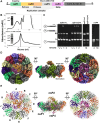Molecular architecture of the Chikungunya virus replication complex
- PMID: 36449616
- PMCID: PMC9710867
- DOI: 10.1126/sciadv.add2536
Molecular architecture of the Chikungunya virus replication complex
Abstract
To better understand how positive-strand (+) RNA viruses assemble membrane-associated replication complexes (RCs) to synthesize, process, and transport viral RNA in virus-infected cells, we determined both the high-resolution structure of the core RNA replicase of chikungunya virus and the native RC architecture in its cellular context at subnanometer resolution, using in vitro reconstitution and in situ electron cryotomography, respectively. Within the core RNA replicase, the viral polymerase nsP4, which is in complex with nsP2 helicase-protease, sits in the central pore of the membrane-anchored nsP1 RNA-capping ring. The addition of a large cytoplasmic ring next to the C terminus of nsP1 forms the holo-RNA-RC as observed at the neck of spherules formed in virus-infected cells. These results represent a major conceptual advance in elucidating the molecular mechanisms of RNA virus replication and the principles underlying the molecular architecture of RCs, likely to be shared with many pathogenic (+) RNA viruses.
Figures





References
-
- Gasque P., Bandjee M. C., Reyes M. M., Viasus D., Chikungunya pathogenesis: From the clinics to the bench. J. Infect. Dis. 214, S446–S448 (2016). - PubMed
-
- Albulescu I. C., Tas A., Scholte F. E. M., Snijder E. J., van Hemert M. J., An in vitro assay to study chikungunya virus RNA synthesis and the mode of action of inhibitors. J. Gen. Virol. 95, 2683–2692 (2014). - PubMed
-
- Pietilä M. K., Hellström K., Ahola T., Alphavirus polymerase and RNA replication. Virus Res. 234, 44–57 (2017). - PubMed
Grants and funding
LinkOut - more resources
Full Text Sources
Other Literature Sources

